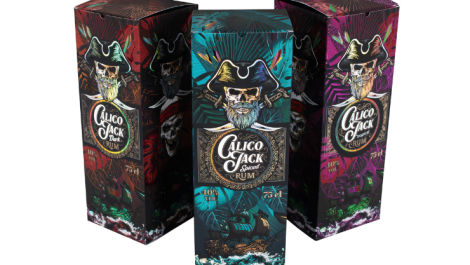Sometimes digital print, however beautiful, is just not enough. This is when the latest print and finishing options have their moments in the spotlight as they can add a variety of haptic and optical surface options.
Print has never been the flat, 2D experience many people think of it as today: it always also meant to emboss, to punch, to varnish, giving the printing substrate very distinct surface characteristics. However, this kind of sensory luxury never came cheap, as the techniques and tools required took a lot of time and effort. Today, print buyers have three very distinct opportunities to add haptic and optical special effects to digital prints: varnishing, structured substrates and laminates. Thanks to digital technology, added value prints also don’t have to overstretch the budget.
Varnishing inline and offline
Of course, most wide-format digital prints are suitable for print varnishing in all the traditional analogue ways: full varnish with a coating line or offset press, full or partial varnish in a screen printing process. There is a wide range of print varnishes available, mainly for silk screen, covering every surface option from very matte to high-gloss. Sandstone and sparkling glitter varnish or even varnishes with fragrances are widely available on the market. When UV-curing inks became a standard for digital printing, manufacturers like Fujifilm started to create inline print varnishing options with their printers. As the additional “Clear Varnish” ink was added, today full or partial varnish can easily be applied onto any digital print in a fast and painless inline process. The Clear Varnish acts basically just like a spot colour, though in the digital printing process no tool or form is required for partial lacquer. It’s the UV lamp settings that determine whether the Clear Varnish inks will dry a matte or glossy surface, or just something in between. By 2008, Roland DG also introduced a textured ink option, as the Clear Vanish is printed in several layers, building up Braille letters, but also leather or wood-grain surfaces. Major print manufacturers, including Agfa, EFI and Mimaki, today offer updated inline textured ink solutions with many of their UV-curing ink printer models.
Printing on a special substrate and leaving some areas unprinted is also a proven method to achieve interesting surfaces with digital print. Aslan offers a Print Metal substrate range suitable for inkjet printing
Texture and gloss is tricky business
While texture and gloss without a doubt can add tremendous value to printing products – just think about a poster advertising an exclusive handbag, with its lush leathers ready to touch right on the printed display! – additional layer(s) of inks also add complexity to a project. It is therefore highly advisable to contact a qualified print service provider in the early design stages. Ideally, design and varnish come together to push a common goal, making the print a sensory experience that is not so easy to forget. As the surface is altered though, unfortunately the colours are, too: A matte varnish usually subdues the colours to a certain degree, while a high-gloss will usually highlight them, making the print appear much more brilliant. With brand colours, this may turn into a problem, more so with partial varnish. It is therefore widely recommended to ask for a proof print with the actual materials, as it is nearly impossible to simulate the effect in a soft proof. This is even more important when also adding texture, as not only the colour may change from a certain angle, but also small, light letters or tiny graphic details might appear to be swallowed by many layers of ink. Not only print and finishing, but also the substrate itself has to be carefully selected when aiming for that unusual surface touch and feel.
The substrate makes the surface
It is important to remember, that creating an interesting surface doesn’t always mean adding an additional layer. Aslan, a manufacturer of self-adhesive films, among others, offers a Print Metal substrate range suitable for inkjet printing. The combination of printed and unprinted metallic areas allow for some beautiful effects. Lots of flexible media, as well as certain boards, for example the Katz Display Board, are available with a Canvas structure. When printed onto with water-based, (eco) solvent or HP Latex inks, the surface structure will be preserved, while UV-curing inks, forming a film, will usually take away most of it. Regardless the digital printing technology, Mesh and structured media may loose most of its characteristics when treated to a thick matte over-coating, very light materials might rip apart easily with the added weight of a high-gloss varnish layer. Very absorptive boards might not dry on time, as very light heat-sensitive foils are prone to crackle under conventional UV-light (but probably are fine with modern UV LED curing): Never miss the chance to rely onto your print service provider’s experience when choosing the right substrate for your added value surface structure project.
Semi-relief vinyl layers: Using several layers of printed or coloured vinyl makes interesting surfaces, especially for car wraps
Laminates are an alternative
Laminates are thin foils often used in the sign-making industry, for example to protect the print on a wrapped car against aggressive detergents or brush abrasion in a car wash. There are anti-slip-laminates required by law for floor graphics, and UV-laminates, matte and glossy, to extend the outdoor durability of prints. For very high-end car wraps it became fashionable in recent years to use several layers of foil to create semi-relief structures. Many laminates are suitable for cutting plotters, thus may also be partially applied on a print for special effects like Glossy, Matte or Mirror. Mactac has come up with yet another option. Its Permafun range offers a wide variety of surface options like Peach Skin, Leather or Frost. Grafityp GL Glow In The Dark uses tiny phosphor particles for an afterglow effect. Laminates are most often applied by calander on roll-to-roll digital prints on vinyl. It is important though to choose the right combination of printing substrate, ink and laminate for the desired application. High quality cast vinyl print media and laminates are required for 3D wraps, while for flat surfaces calandered vinyls will suffice. Technically, applying laminate to a printed vinyl film makes it a composite material with potentially different specifications and recycling quality.
Gloss and structure
Textured and glossy surfaces magically catch the attention of the human “touchy-feely” animal. With digital wide format printing, designers and print buyers have a broad range of options to turn even the wildest creative idea into reality. Print service providers and sign makers can help to make even the most complex project a smooth journey.
The Wild Format guides are intended to expand awareness and understanding of the craziness that can be created on wide format digital printing devices, from floors to lampshades and everything in between.
These guides are made possible by a group of manufacturers working together with Digital Dots.
This article is supported by Efi, Fujifilm, HP and Digital Dots.
Together we hope you enjoy the articles and that you put into practice what you learn. If you want to talk about it, go to our LinkedIn group.
Enjoy and Go Wild!





